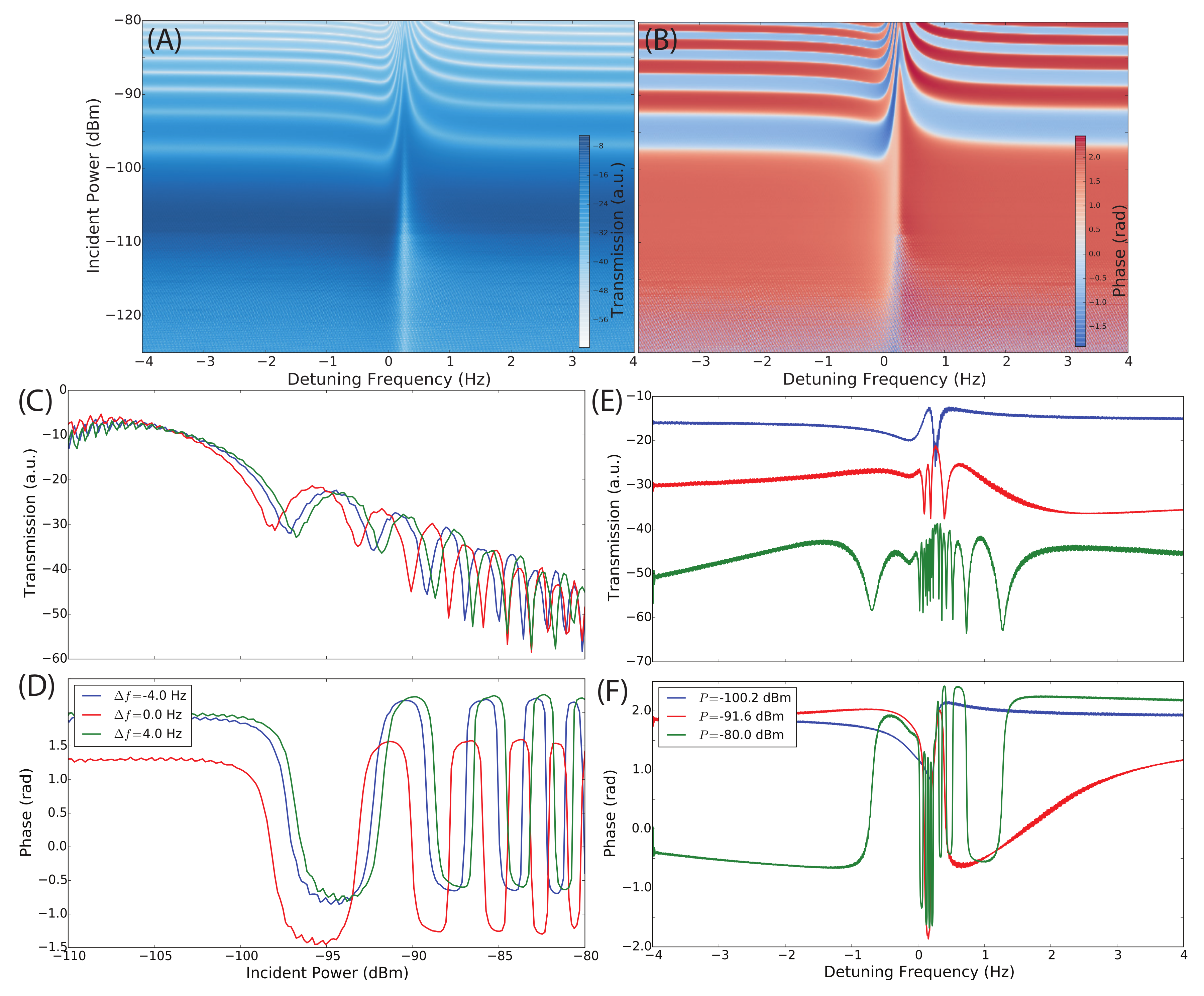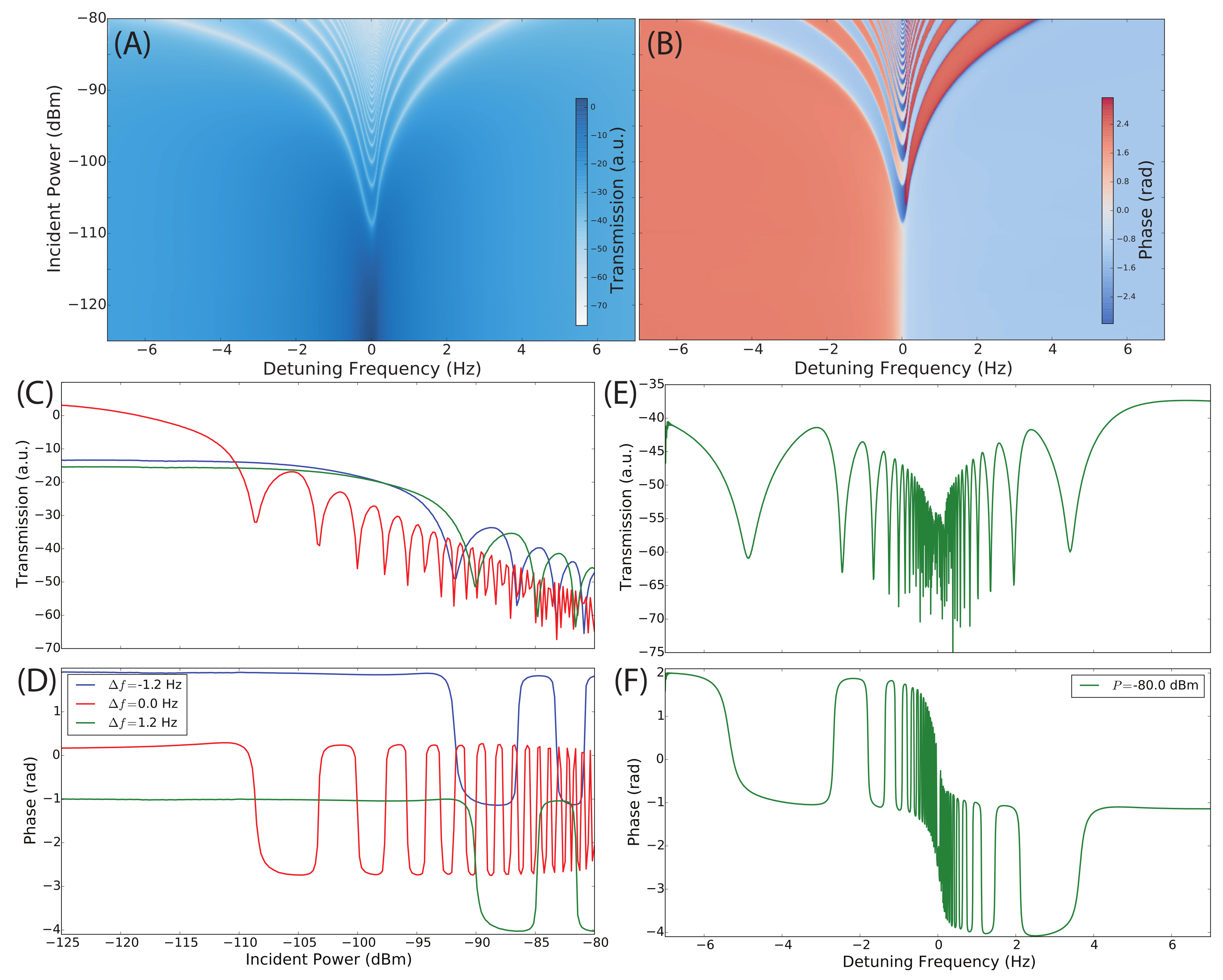Inducing Strong Non-Linearities in a Phonon Trapping Quartz Bulk Acoustic Wave Resonator Coupled to a Superconducting Quantum Interference Device
Abstract
:1. Introduction
2. Results: Towards a Cryogenic Quartz Oscillator
3. Discussion
Acknowledgments
Author Contributions
Conflicts of Interest
References
- Nagel, M.; Parker, S.R.; Kovalchuk, E.V.; Stanwix, P.L.; Hartnett, J.G.; Ivanov, E.N.; Peters, A.; Tobar, M.E. Direct terrestrial test of Lorentz symmetry in electrodynamics to 10−18. Nat. Commun. 2015, 6, 8174. [Google Scholar] [CrossRef] [PubMed]
- Abgrall, M.; Guéna, J.; Lours, M.; Santarelli, G.; Tobar, M.E.; Bize, S.; Grop, S.; Dubois, B.; Fluhr, C.; Giordano, V. High-Stability Comparison of Atomic Fountains Using Two Different Cryogenic Oscillators. IEEE Trans. Ultrason. Ferroelectr. Freq. Control 2016, 63, 1198–1203. [Google Scholar] [CrossRef] [PubMed]
- Ivanov, E.N.; Tobar, M.E. Low phase-noise microwave oscillators with interferometric signal processing. IEEE Trans. Microw. Theory Tech. 2006, 54, 3284–3294. [Google Scholar] [CrossRef]
- Ivanov, E.N.; Tobar, M.E. Low phase-noise sapphire crystal microwave oscillators: Current status. IEEE Trans. Ultrason. Ferroelectr. Freq. Control 2009, 56, 263–269. [Google Scholar] [CrossRef] [PubMed]
- Locke, C.R.; Ivanov, E.N.; Hartnett, J.G.; Stanwix, P.L.; Tobar, M.E. Invited Article: Design techniques and noise properties of ultrastable cryogenically cooled sapphire-dielectric resonator oscillators. Rev. Sci. Instrum. 2008, 79, 051301. [Google Scholar] [CrossRef] [PubMed]
- Millo, J.; Abgrall, M.; Lours, M.; English, E.M.L.; Jiang, H.; Guéna, J.; Clairon, A.; Tobar, M.E.; Bize, S.; Coq, Y.L.; et al. Ultralow noise microwave generation with fiber-based optical frequency comb and application to atomic fountain clock. Appl. Phys. Lett. 2009, 94, 141105. [Google Scholar] [CrossRef]
- Fortier, T.M.; Rolland, A.; Quinlan, F.; Baynes, F.N.; Metcalf, A.J.; Hati, A.; Ludlow, A.D.; Hinkley, N.; Shimizu, M.; Ishibashi, T.; et al. Optically referenced broadband electronic synthesizer with 15 digits of resolution. Laser Photonics Rev. 2016, 10, 780–790. [Google Scholar] [CrossRef]
- Baynes, F.N.; Quinlan, F.; Fortier, T.M.; Zhou, Q.; Beling, A.; Campbell, J.C.; Diddams, S.A. Attosecond timing in optical-to-electrical conversion. Optica 2015, 2, 141–146. [Google Scholar] [CrossRef]
- Diddams, S.A. The evolving optical frequency comb. J. Opt. Soc. Am. B 2010, 27, B51–B62. [Google Scholar] [CrossRef]
- Fortier, T.M.; Kirchner, M.S.; Quinlan, F.; Taylor, J.; Bergquist, J.C.; Rosenband, T.; Lemke, N.; Ludlow, A.; Jiang, Y.; Oates, C.W.; et al. Generation of ultrastable microwaves via optical frequency division. Nat. Photonics 2011, 5, 425. [Google Scholar] [CrossRef]
- Grudinin, I.S.; Lee, H.; Painter, O.; Vahala, K.J. Phonon Laser Action in a Tunable Two-Level System. Phys. Rev. Lett. 2010, 104, 083901. [Google Scholar] [CrossRef] [PubMed]
- Luan, X.; Huang, Y.; Li, Y.; McMillan, J.F.; Zheng, J.; Huang, S.W.; Hsieh, P.C.; Gu, T.; Wang, D.; Hati, A.; et al. An integrated low phase noise radiation-pressure-driven optomechanical oscillator chipset. Sci. Rep. 2014, 4, 6842. [Google Scholar] [CrossRef] [PubMed]
- Seok, H.; Wright, E.M.; Meystre, P. Dynamic stabilization of an optomechanical oscillator. Phys. Rev. A 2014, 90, 043840. [Google Scholar] [CrossRef]
- Hossein-Zadeh, M.; Vahala, K.J. Observation of injection locking in an optomechanical rf oscillator. Appl. Phys. Lett. 2008, 93, 191115. [Google Scholar] [CrossRef]
- Li, J.; Yi, X.; Lee, H.; Diddams, S.A.; Vahala, K.J. Electro-optical frequency division and stable microwave synthesis. Science 2014, 345, 309–313. [Google Scholar] [CrossRef] [PubMed]
- Tomes, M.; Carmon, T. Photonic Micro-Electromechanical Systems Vibrating at X-band (11-GHz) Rates. Phys. Rev. Lett. 2009, 102, 113601. [Google Scholar] [CrossRef] [PubMed]
- Grudinin, I.S.; Matsko, A.B.; Maleki, L. Brillouin Lasing with a CaF Whispering Gallery Mode Resonator. Phys. Rev. Lett. 2009, 102, 043902. [Google Scholar] [CrossRef] [PubMed]
- Lee, H.; Chen, T.; Li, J.; Yang, K.Y.; Jeon, S.; Painter, O.; Vahala, K.J. Chemically etched ultrahigh-Q wedge-resonator on a silicon chip. Nat. Photonics 2012, 6, 369–373. [Google Scholar] [CrossRef]
- Li, J.; Lee, H.; Chen, T.; Vahala, K.J. Characterization of a high coherence, Brillouin microcavity laser on silicon. Opt. Express 2012, 20, 20170–20180. [Google Scholar] [CrossRef] [PubMed]
- Salzenstein, P.; Kuna, A.; Sojdr, L.; Chauvin, J. Significant step in ultra-high stability quartz crystal oscillators. Electron. Lett. 2010, 46, 1433–1434. [Google Scholar] [CrossRef]
- Galliou, S.; Goryachev, M.; Bourquin, R.; Abbe, P.; Aubry, J.; Tobar, M. Extremely Low Loss Phonon-Trapping Cryogenic Acoustic Cavities for Future Physical Experiments. Nat. Sci. Rep. 2013, 3, 2132. [Google Scholar] [CrossRef] [PubMed]
- Aspelmeyer, M.; Kippenberg, T.J.; Marquardt, F. Cavity optomechanics. Rev. Mod. Phys. 2014, 86, 1391–1452. [Google Scholar] [CrossRef]
- Renninger, W.H.; Kharel, P.; Behunin, R.O.; Rakich, P.T. Bulk crystalline optomechanics. arXiv, 2017; arXiv:1703.08231. [Google Scholar]
- Goryachev, M.; Creedon, D.; Galliou, S.; Tobar, M. Observation of Rayleigh phonon scattering through excitation of extremely high overtones in low-loss cryogenic acoustic cavities for hybrid quantum systems. Phys. Rev. Lett. 2013, 111, 085502. [Google Scholar] [CrossRef] [PubMed]
- Teufel, J.D.; Li, D.; Allman, M.S.; Cicak, K.; Sirois, A.J.; Whittaker, J.D.; Simmonds, R.W. Circuit cavity electromechanics in the strong-coupling regime. Nature 2011, 471, 204. [Google Scholar] [CrossRef] [PubMed]
- Hofheinz, M.; Wang, H.; Ansmann, M.; Bialczak, R.C.; Lucero, E.; Neeley, M.; O’Connell, A.D.; Sank, D.; Wenner, J.; Martinis, J.M.; et al. Synthesizing arbitrary quantum states in a superconducting resonator. Nature 2009, 459, 546–549. [Google Scholar] [CrossRef] [PubMed]
- Goryachev, M.; Ivanov, E.N.; van Kann, F.; Galliou, S.; Tobar, M.E. Observation of the fundamental Nyquist noise limit in an ultra-high Q-factor cryogenic bulk acoustic wave cavity. Appl. Phys. Lett. 2014, 105, 153505. [Google Scholar] [CrossRef]
- Lo, A.; Haslinger, P.; Mizrachi, E.; Anderegg, L.; Müller, H.; Hohensee, M.; Goryachev, M.; Tobar, M.E. Acoustic Tests of Lorentz Symmetry Using Quartz Oscillators. Phys. Rev. X 2016, 6, 011018. [Google Scholar] [CrossRef]
- Goryachev, M.; Creedon, D.; Ivanov, E.; Galliou, S.; Bourquin, R.; Tobar, M. Extremely low-loss acoustic phonons in a quartz bulk acoustic wave resonator at millikelvin temperature. Appl. Phys. Lett. 2012, 100, 243504. [Google Scholar] [CrossRef]
- Bon, J.; Galliou, S.; Bourquin, R. Temperature coefficients of crystalline-quartz elastic constants over the cryogenic range [4 K, 15 K]. Appl. Phys. Lett. 2016, 109, 231902. [Google Scholar] [CrossRef]
- Clarke, J.; Braginski, A. The SQUID Handbook: Fundamentals and Technology of SQUIDs and SQUID Systems; Wiley-VCH: Weinheim, Germany, 2004. [Google Scholar]
- Xu, B.; Hamilton, W.O. Analysis of dc SQUID readout for a gravity wave detector using an inductive transducer. J. Appl. Phys. 1985, 57, 1729–1733. [Google Scholar] [CrossRef]
- Pleikies, J.; Usenko, O.; Kuit, K.; Flokstra, J.; De Waard, A.; Frossati, G. SQUID Developments for the Gravitational Wave Antenna MiniGRAIL. IEEE Trans. Appl. Supercond. 2007, 17, 764–767. [Google Scholar] [CrossRef]
- Goryachev, M.; Tobar, M.E. Gravitational wave detection with high frequency phonon trapping acoustic cavities. Phys. Rev. D 2014, 90, 102005. [Google Scholar] [CrossRef]
- O’Connell, A.D.; Hofheinz, M.; Ansmann, M.; Bialczak, R.C.; Lenander, M.; Lucero, E.; Neeley, M.; Sank, D.; Wang, H.; Weides, M.; et al. Quantum ground state and single-phonon control of a mechanical resonator. Nature 2010, 464, 697–703. [Google Scholar] [CrossRef] [PubMed]
- Woolley, M.J.; Emzir, M.F.; Milburn, G.J.; Jerger, M.; Goryachev, M.; Tobar, M.E.; Fedorov, A. Quartz-superconductor quantum electromechanical system. Phys. Rev. B 2016, 93, 224518. [Google Scholar] [CrossRef]
- Ivanov, E.N.; Goryachev, M.; Galliou, S.; Tobar, M.E. Pound Stabilized Cryogenic Bulk Acoustic Wave Resonator-Oscillator. In Proceedings of the 2018 IEEE Int’l Frequency Control Symposium (2018 IFCS), Lake Tahoe, CA, USA, 21–24 May 2018. [Google Scholar]
- ANSI/IEEE. IEEE Standard on Piezoelectricity; Std 176-1987; Institute of Electrical and Electronics Engineers: New York, NY, USA, 1988. [Google Scholar]
- Besson, R.; Peier, U. Further Advances on BVA Quartz Resonators. In Proceedings of the 34th Annual Symposium on Frequency Control, Philadelphia, PA, USA, 28–30 May 1980; pp. 175–182. [Google Scholar]
- Gagnepain, J. Non Linear Mechanisms in Quartz Crystal Resonators. Ph.D. Thesis, University of Franche Comté, Besancon, France, 1972. [Google Scholar]
- Gagnepain, J.; Besson, R. Physical Acoustics; Chapter Nonlinear Effects in Piezoelectric Quartz Crystals; Elsevier: New York, NY, USA, 2012; Volume 11, pp. 245–288. [Google Scholar]
- Tiersten, H.; Stevens, D. An analysis of nonlinear resonance in contoured-quartz crystal resonators. J. Acoust. Soc. Am. 1986, 80, 1122–1132. [Google Scholar] [CrossRef]
- Nosek, J. Drive level dependence of the resonant frequency in BAW quartz resonators and his modeling. IEEE Trans. Ultrason. Ferroelectr. Freq. Control 1999, 46, 823–829. [Google Scholar] [CrossRef] [PubMed]
- Tiersten, H. On the nonlinear equations of thermoelectroelasticity. Int. J. Eng. Sci. 1971, 9, 587–604. [Google Scholar] [CrossRef]
- Goryachev, M.; Galliou, S.; Imbaud, J.; Bourquin, R.; Abbé, P. Recent investigations on BAW resonators at cryogenic temperatures. In Proceedings of the EFTF & IEEE IFCS Joint Meeting, San Francisco, CA, USA, 2–5 May 2011. [Google Scholar]
- Goryachev, M.; Farr, W.; Ivanov, E.; Tobar, M. Anomalously strong nonlinearity of unswept quartz acoustic cavities at liquid helium temperatures. J. Appl. Phys. 2013, 114, 094506. [Google Scholar] [CrossRef]
- Krylov, N.; Bogolyubov, N. Introduction to Non-Linear Mechanics; Princeton Univercity Press: Princeton, NJ, USA, 1947. [Google Scholar]
- Nayfeh, A.; Mook, D. Nonlinear Oscillations; John Wiley and Sons: New York, NY, USA, 1979. [Google Scholar]
- Nakhla, M.; Vlach, J. A piecewise harmonic balance technique for determination of periodic response of nonlinear systems. IEEE Trans. Circuits Syst. 1976, 23, 85–91. [Google Scholar] [CrossRef]
- Gilmore, R.J.; Steer, M.B. Nonlinear circuit analysis using the method of harmonic balance—A review of the art. Part I. Introductory concepts. Int. J. Microw. Millim.-Wave Comput.-Aided Eng. 1991, 1, 22–37. [Google Scholar] [CrossRef]
- Agilent Technologies, Inc. Harmonic Balance Simulation. 2011. Available online: http://edadownload.software.keysight.com/eedl/ads/2011_01/pdf/cktsimhb.pdf (accessed on 10 April 2018).
- Simulation and Analysis Guide; AWR Design Environment v13.03 Edition; NI Company: El Segundo, CA, USA, 2017.
- Gagnepain, J.J.; Oliver, M.; Walls, F.L. Excess Noise in Quartz Crystal Resonators. In Proceedings of the 37th Annual Symposium on Frequency Control, Philadelphia, PA, USA, 1–3 June 1983; pp. 218–225. [Google Scholar]
- Goryachev, M.; Galliou, S.; Imbaud, J.; Abbé, P. Advances in development of quartz crystal oscillators at liquid helium temperatures. Cryogenics 2013, 57, 104–112. [Google Scholar] [CrossRef]



© 2018 by the authors. Licensee MDPI, Basel, Switzerland. This article is an open access article distributed under the terms and conditions of the Creative Commons Attribution (CC BY) license (http://creativecommons.org/licenses/by/4.0/).
Share and Cite
Goryachev, M.; Ivanov, E.N.; Galliou, S.; Tobar, M.E. Inducing Strong Non-Linearities in a Phonon Trapping Quartz Bulk Acoustic Wave Resonator Coupled to a Superconducting Quantum Interference Device. Appl. Sci. 2018, 8, 602. https://doi.org/10.3390/app8040602
Goryachev M, Ivanov EN, Galliou S, Tobar ME. Inducing Strong Non-Linearities in a Phonon Trapping Quartz Bulk Acoustic Wave Resonator Coupled to a Superconducting Quantum Interference Device. Applied Sciences. 2018; 8(4):602. https://doi.org/10.3390/app8040602
Chicago/Turabian StyleGoryachev, Maxim, Eugene N. Ivanov, Serge Galliou, and Michael E. Tobar. 2018. "Inducing Strong Non-Linearities in a Phonon Trapping Quartz Bulk Acoustic Wave Resonator Coupled to a Superconducting Quantum Interference Device" Applied Sciences 8, no. 4: 602. https://doi.org/10.3390/app8040602
APA StyleGoryachev, M., Ivanov, E. N., Galliou, S., & Tobar, M. E. (2018). Inducing Strong Non-Linearities in a Phonon Trapping Quartz Bulk Acoustic Wave Resonator Coupled to a Superconducting Quantum Interference Device. Applied Sciences, 8(4), 602. https://doi.org/10.3390/app8040602




